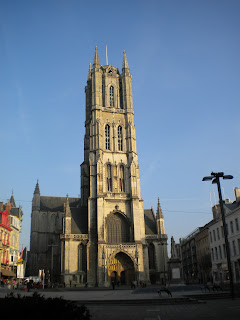Ghent´s phenomenal zenith, when, for example, I understand it grew to become the biggest European city in the 1500´s after Paris and London, was followed by a long decline, which, as with at least a few other cities, helped to save some of its heritage, and when the Industrial Revolution spurred new growth in the 19th century, the town demolished sizeable chunks of the Medieval and Renaissance heritage which may be the city´s main heritage draw today, but in the old town center or nearby created other streetscapes which are great today, such as this one....
looking east on Vlanderen Straat towards Brabantdam
and all of its components, like this 1889 building....
Vlanderenstraat 66 (that´s how they often roll...off the tongue here!)
There are blocks and blocks of lively late 19th-century heritage here, but in this writing, I´ll focus mostly on two highpoints within one block....
St. Bavo´s Cathedral
I honestly do not know how this ranks within a listing of Gothic cathedrals, but it obviously has an impressive space and a rich offering of historic art, and one pinnacle in art history in general.
When I entered the Cathedral, I was moved as I had not been last week at its very rough contemporary of Amsterdam´s "Nieuwe Kerk", and I have quickly realized that one likely reason is that... I didn´t pay a fee of 18 euros (about $24) there to see it and a current exhibit there more fully, but that price also became part of the Nieuwe Kerk´s commercialism, if restrained, and while that Amsterdam monument is next to the "carnival" of the Dam Square, St. Bavo´s front yard, known in Flemish as Sint Baaf´s Plein, is not as much of a draw, attractively so at times, and can even be strangely quiet, as was the case yesterday and at around 5:30pm today, with the Cathedral on its east side....
Stepping in to the church through its north transept, one of the first paintings you see is one of its more famous holdings, "Saint Bavo´s Entrance into the Monastery of Ghent", by Peter Paul Rubens....
While I would get the sense that seasoned travelers might tire of one European Gothic cathedral after another, this one - my first as an adult, was beautiful, as in the south transept....
and the views to the east end through the choir area....
and to the east end of the sanctuary....
All of this would be enjoyable enough, but, as with other such long-established institutions, later aesthetics were added and have continued to be added, including Baroque glories such as the main altar, constructed from 1705-19 and depicting "Saint Bavo´s Apotheosis"....
and a fairly large amount of stained-glass windows from after 1850, including this one of the mid-1990´s....
one of two windows in Vijd´s Chapel by artist Herman Blondeel done in 1994-96
That depiction of the nude woman you may have been looking at at the lower left is Eve, and she is there thanks partly to the "Vijd" of the caption above - Joos Vijd....
- a wealthy "Gentenaar" (citizen of Ghent), pictured here, along with his separately "paneled" wife, Elisabeth Boorlut...
as part of the "Ghent Altarpiece", whose inside panels, seen at least in a rough approximation here....
have become one of the greatest art works ever, famed for elements I could only begin to show with a ... better camera, but including their realism, detail and brilliant color, and a product finished for the afore-mentioned "Vijd Chapel" in 1432 by brothers Jan and Hubert Van Eyck.
Seeing this legend, protected behind a large glass case in a small room off of the front of St. Bavo´s, was well-worth the 4 euros I believe I paid to see it and pick up a free head-set with explanations set partly to reverent Medieval music.
The Belfort
...seen from just west of it, with St. Bavo's Church in the right background
The Belfort is a beautiful tower begun in the early 1300's, both to communicate to townspeople through its carillons over the years and to store the most important records for the city. It has come to be one of the most treasured structures of its kind and has been on a UNESCO list of world heritage sites since 1999.
In walking up its more than 230 steps to a glorious viewing area in all four directions, I considered it a place of mystery and anticipation, though the "sense of mystery award" would go on my very short "Ghent" list to a medieval castle known as Gravensteen, once the powerful base for the Counts of Flanders in their fight with proud citizens of Ghent, and seen here....
(from the southeast corner of Burgstraat and Jan Breydel Straat)
Both are thick-walled medieval constructions, with the Belfort very much for the city of Ghent per se, while the Gravensteen was literally outside the city limits at the time of its first use in 1180, and meant to intimidate Ghentenaars into respect for the rulers of their province of Flanders.
At the Belfort, I paid 6 euros (about $8), very much worth the walk up a fairly narrow spiral staircase....
looking into steps from "Tower Keepers" level to Bell Collection area
which led to displays and treasures along the way, including a dragon used as the Belfort's weather vane in the mid-1800's....


 Historical Tour Guide
Historical Tour Guide


















No comments:
Post a Comment